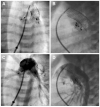Long-term outcome of palliation with internal pulmonary artery bands after primary heart transplantation for hypoplastic left heart syndrome
- PMID: 19365660
- PMCID: PMC3117302
- DOI: 10.1007/s00246-009-9424-3
Long-term outcome of palliation with internal pulmonary artery bands after primary heart transplantation for hypoplastic left heart syndrome
Abstract
The purpose of this study was to describe the long-term outcome of infants with hypoplastic left heart syndrome (HLHS) who underwent placement of internal pulmonary artery bands as part of a transcatheter palliation procedure followed by primary heart transplantation. Transcatheter palliation included stenting of the ductus arteriosus, decompression of the left atrium by atrial septostomy, and internal pulmonary artery band placement. Cardiac hemodynamics, pulmonary artery architecture, and pulmonary artery growth since transplantation are described. Nine infants with HLHS had internal pulmonary artery bands placed and underwent successful heart transplant. No infant required reconstruction of the pulmonary arteries at the time of transplant. At 1 year after transplant, all of the recipients had normal mean pulmonary artery pressure, pulmonary vascular resistance, and transpulmonary gradient. Pulmonary angiography performed at 1 year after transplant demonstrated no distortion of pulmonary artery anatomy with significant interval growth of the branch pulmonary arteries. There was 100% survival to hospital discharge after transplant in this cohort of infants. Transcatheter placement of internal pulmonary artery bands for HLHS offers protection of the pulmonary vascular bed while preserving pulmonary artery architecture and growth with good long-term outcome.
Figures



References
-
- Akintuerk H, Michel-Behnke I, Valeske K, Mueller M, Thul J, Bauer J, Hagel KJ, Kreuder J, Vogt P, Schranz D. Stenting of the arterial duct and banding of the pulmonary arteries: Basis for combined Norwood stage I and II repair in hypoplastic left heart. Circulation. 2002;105:1099–1103. - PubMed
-
- Artrip JH, Campbell DN, Ivy DD, Almodovar MC, Chan KC, Mitchell MB, Clarke DR, Lacour-Gayet F. Birth weight and complexity are significant factors for the management of hypoplastic left heart syndrome. Ann Thorac Surg. 2006;82:1252–1259. - PubMed
-
- Ashburn DA, McCrindle BW, Tchervenkov CI, Jacobs ML, Lofland GK, Bove EL, Spray TL, Williams WG, Blackstone EH. Outcomes after the Norwood operation in neonates with critical aortic stenosis or aortic valve atresia. J Thorac Cardiovasc Surg. 2003;125:1070–1082. - PubMed
-
- Bichell DP, Lamberti JJ, Pelletier GJ, Hoecker C, Cocalis MW, Ing FF, Jensen RA. Late left pulmonary artery stenosis after the Norwood procedure is prevented by a modification in shunt construction. Ann Thorac Surg. 2005;79:1656–1661. - PubMed
-
- Boucek MM, Mashburn C, Chan KC. Catheter-based interventional palliation for hypoplastic left heart syndrome. Semin Thorac Cardiovasc Surg Pediatr Card Surg Annu. 2005;8:72–77. - PubMed
MeSH terms
Grants and funding
LinkOut - more resources
Full Text Sources
Medical

